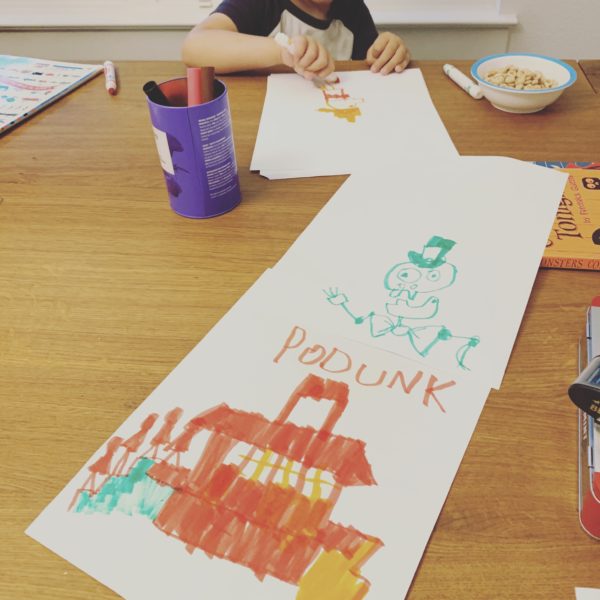
Somehow the 4-year-old got the idea that a caboose is called a “podunk” and why on Earth would I ever set him straight?
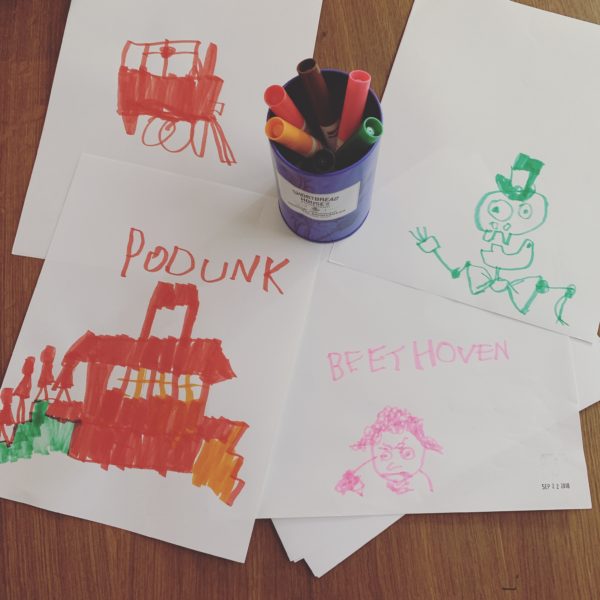
He also drew this incredible drawing of Beethoven:
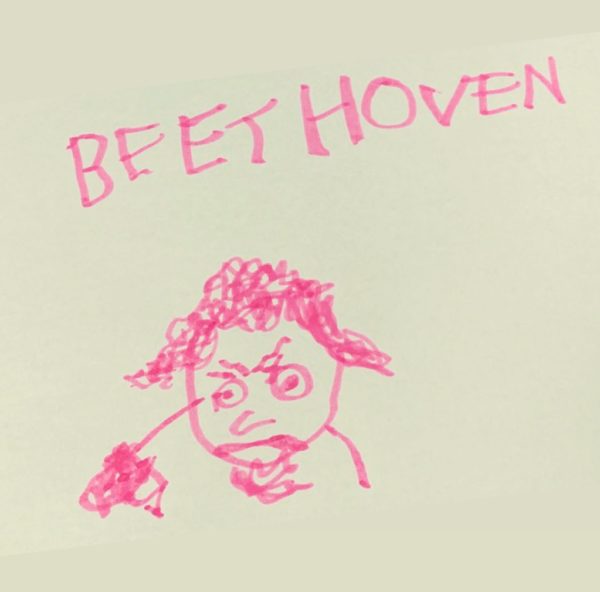
(A lot happens around the kitchen table before 9AM.)

Somehow the 4-year-old got the idea that a caboose is called a “podunk” and why on Earth would I ever set him straight?

He also drew this incredible drawing of Beethoven:

(A lot happens around the kitchen table before 9AM.)
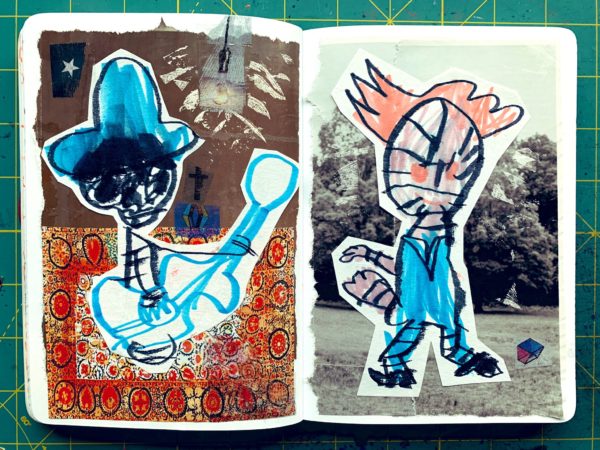
Haven’t much felt like writing in my diary, so I’ve been making collages.
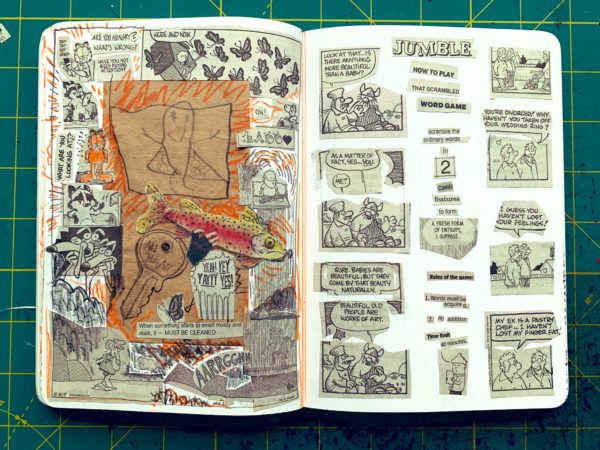
Whenever I get my hands on a comics page from the newspaper, I cut them up and play.
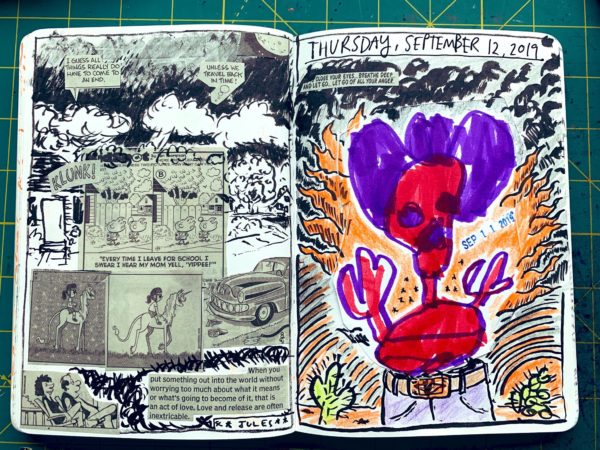
I hoard drawings from my 4-year-old to fill the pages.
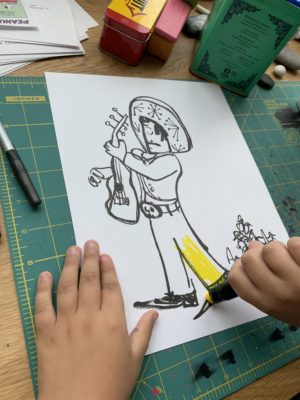
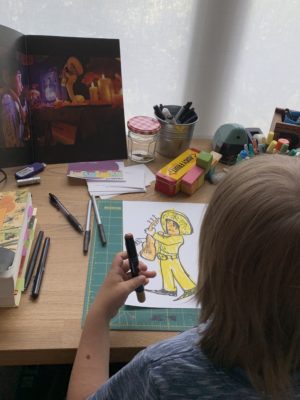
Yesterday the 4-year-old brought his book of Coco sheet music into the studio and I copied a statue of Ernesto de la Cruz for him to color.
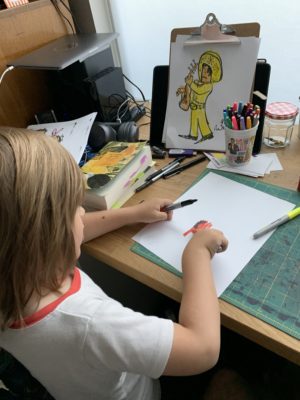

Today he came in and wanted to copy my copy. He had trouble starting, so I drew Ernesto’s head and torso, and he finished up his legs, arms, and guitar. I like our copy of the copy even more:
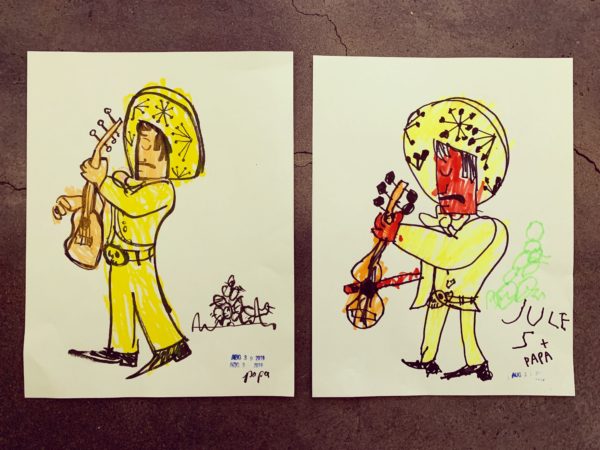
This happens a lot when I’m drawing solo: I’ll attempt a drawing of something from life, and then if I copy that drawing, simplifying the lines, I get something more reduced and interesting.
Now I’m wondering what a third step would look like. A copy of a copy of a copy…
Related: Copying is how we learn.
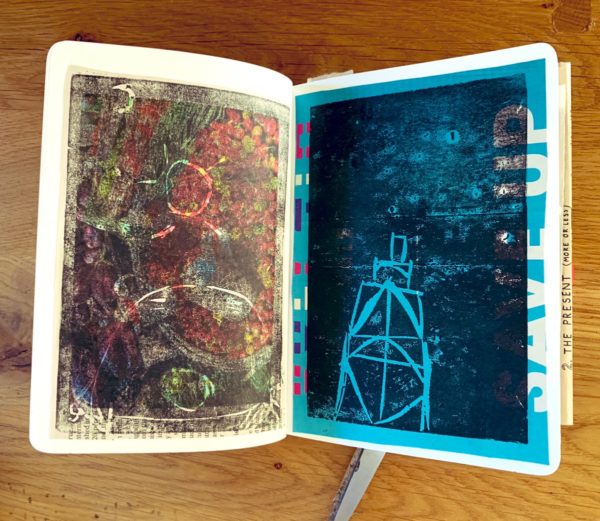
Here are some linocut prints carved by my six-year-old, printed by me on a photo and an advertisement from the New York Times. (The one on the left reminds me of Corita Kent. “Save up” vs. “Power up.”)

I like how the prints (made with cheap Speedball blocks and ink) look like laser print-outs low on toner. Raw and spooky. The one on the left had little bits dirt or food stuck to it, so it ended up looking like stars around the tower. (I was thinking while we were making these that there’s no reason to ever participate in an art-making process unless there’s some chance for happy accidents and moments of serendipity.)

Here’s what the kitchen table looked like by 9AM.
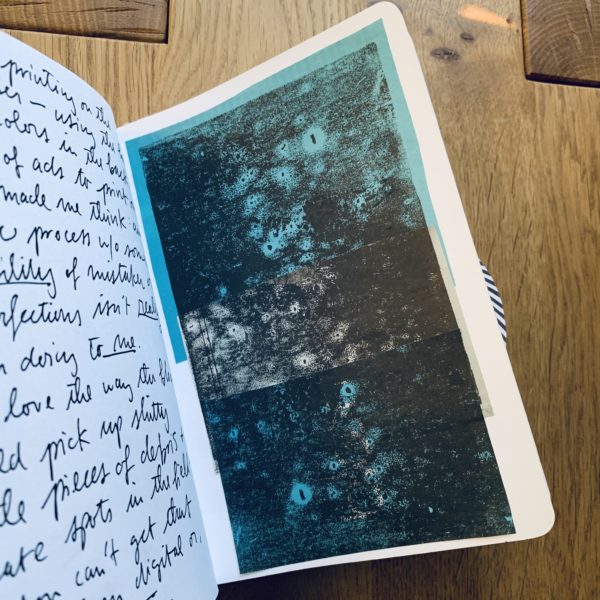
I love cutting up the discarded prints and collaging them into something else…
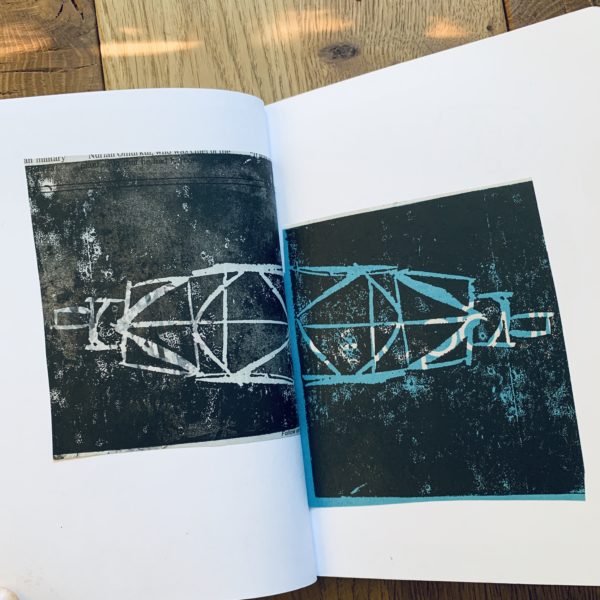
…and extending abstract shapes into new forms.


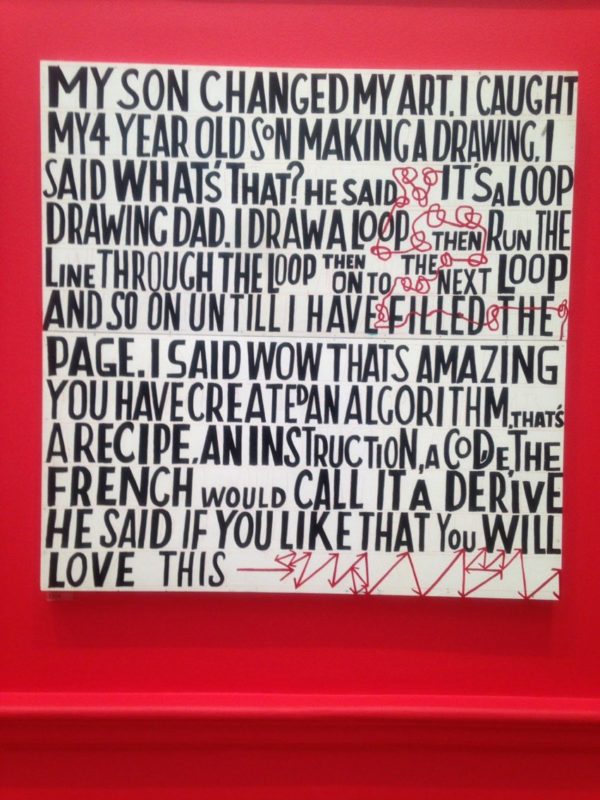
I learned so much about art from watching a kid draw. I taught at the grade-school level. Kids don’t call it art when they’re throwing things around, drawing—they’re just doing stuff.
—John Baldessari
When I talk to artists who are “stuck” I often think they should be prescribed a session with some four-year-olds. (Borrow a kid!) Four-year-olds are the most “unstuck” creatures around. To watch a four-year-old draw is to watch some kind of magic happen, magic that, even in two or three years, will not come naturally, but will need to be conjured, somehow.

Lynda Barry does this at the University of Wisconsin:
“When I came to the university… one thing that struck me was how miserable the grad students were. I thought, I wonder if I could pair them up with four-year-olds?” She started a program called Draw Bridge that did just that. “What I hoped would happen was my students would learn to borrow the kids’ state of mind and learn to approach problems in a way that was less tight and focused, a way that was happier and set the conditions for discovery.”
If you follow Lynda on Instagram, she often posts her collaborations with four-year-olds:
https://www.instagram.com/p/ByGER_QgzuS
Here’s one about drawing Batman:
https://www.instagram.com/p/Bxyh16rl1Ke/?utm_source=ig_web_copy_link
And here are some 4-year-olds doing a copying exercise:
https://www.instagram.com/p/BxeFX6KDKEf/?utm_source=ig_web_copy_link
I’m lucky right now because I live with a four-year-old and I get to spend a lot of time with him, watching him draw. (Although, I’m telling you: it’s a lot easier to just borrow one and hand them back!) If you came to one of the Keep Going tour dates, you saw this slide of Jules drawing when he was three:

(I write more about his drawing in the “Your Work is Play” section of the book.)
This is my second time around living with a four-year-old. This one is a little more introverted than the first one. I did a lot more collaborating with the first. I remember transcribing some of his wild monologues:
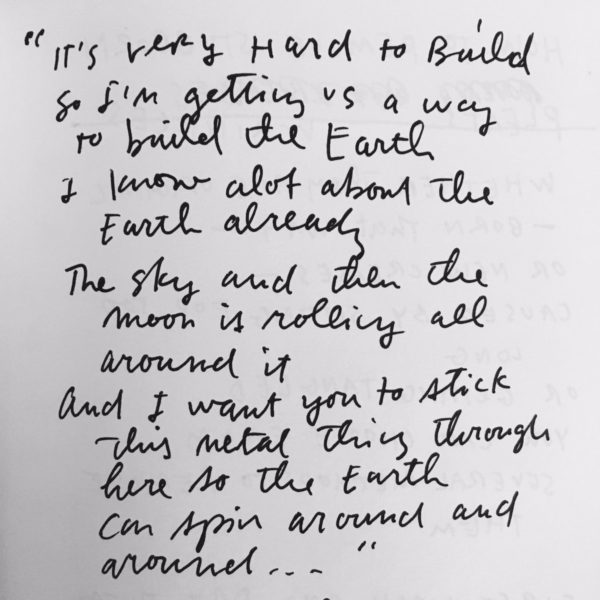
He was basically an ecstatic poet!
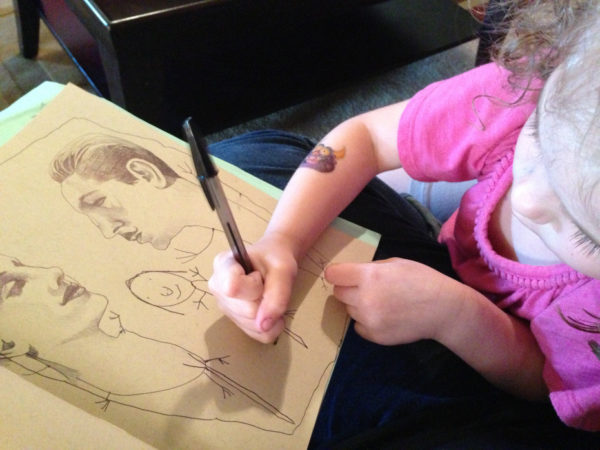
I have two daughters that could both draw like Albrecht Durer when they were about seven years old, before the teachers got ahold of them.
—Kurt Vonnegut
I’m also reminded now of illustrator Mica Angela Hendricks and her collaborations with her 4-year-old daughter, which started out when her daughter saw her sketchbook and asked if she could draw, too. She eventually started draw unfinished heads at night so her daughter could finish them in the morning. “Do you have any heads for me today?” her daughter would ask.

Hanging out with his four-year-old niece led animator Don Hertzfeldt to some of the best parts of his absolutely incredible short, World of Tomorrow. Here’s how it went:
My niece, Winona, contributes the voice of little Emily. She was 4 when I recorded her. You can’t direct a 4-year-old, I learned that really fast. I couldn’t even get her to repeat lines for me. So I just recorded audio as we drew pictures together, played with stuff, talked about the world. I was pretty aware that if the recordings produced nothing, the film would have been dead before it even began. She lives in Scotland and I am in Austin, so I usually only get to see her about once a year. After a weeklong visit, recording five minutes here and there, I had about an hour or so of total recorded time with her. So the first step was finding all of her best reactions and questions, and I began to figure out what her character could be talking about here, or looking at there.
“You can’t direct a 4-year-old…” Truer words never spoken! All you can do is set them up and hit record. And hang on for the ride…
This site participates in the Amazon Affiliates program, the proceeds of which keep it free for anyone to read.